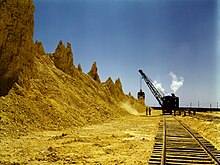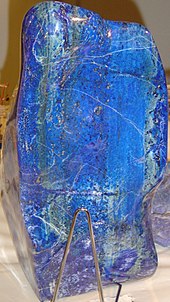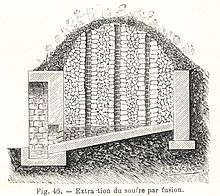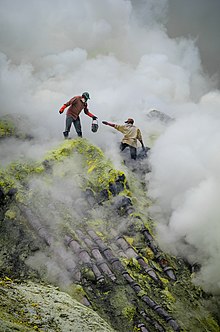Proposed solar radiation management using a tethered balloon to inject sulfate aerosols into the stratosphere.
Solar radiation management (SRM) projects are a type of climate engineering which seek to reflect sunlight and thus reduce global warming. Proposed methods include increasing the planetary albedo, for example using stratospheric sulfate aerosols.
Restorative methods have been proposed regarding the protection of
natural heat reflectors like sea ice, snow and glaciers with engineering
projects.
Their principal advantages as an approach to climate engineering is the
speed with which they can be deployed and become fully active, their
potential low financial cost, and the reversibility of their direct
climatic effects.
Solar radiation management projects could serve as a temporary
response while levels of greenhouse gases can be brought under control
by mitigation and greenhouse gas removal techniques. They would not reduce greenhouse gas concentrations in the atmosphere, and thus do not address problems such as ocean acidification caused by excess carbon dioxide (CO2).
Purpose
Climate engineering projects have been proposed in order to reduce global warming. As early as 1974, Russian expert Mikhail Budyko
suggested that if global warming became a problem, we could cool down
the planet by burning sulfur in the stratosphere, which would create a
haze. The annual cost of delivering a sufficient amount of sulfur to
counteract expected greenhouse warming is estimated at 2 to 8 billion
USD.
A preliminary study by Edward Teller
and others in 1997 presented the pros and cons of various relatively
"low-tech" proposals to mitigate global warming through
scattering/reflecting sunlight away from the Earth via insertion of
various materials in the upper stratosphere, low earth orbit, and L1 locations.
By modifying the albedo of the Earth's surface, or by preventing sunlight reaching the Earth by using a solar shade, the sun's warming effect can be cancelled out—although the cancellation is imperfect, with regional discrepancies remaining.
SRM or albedo modification, is considered to be a potential option for addressing climate change. As the National Academy of Sciences
states in its 2015 report: "The two main options for responding to the
risks of climate change involve mitigation—reducing and eventually
eliminating human-caused emissions of CO2 and other
greenhouse gases (GHGs)—and adaptation—reducing the vulnerability of
human and natural systems to changes in climate. A third potentially
viable option, currently under development but not yet widely deployed,
is carbon dioxide removal
(CDR) from the atmosphere accompanied by reliable sequestration. A
fourth, more speculative family of approaches called albedo modification
seeks to offset climate warming by greenhouse gases by increasing the
amount of sunlight reflected back to space."
In this context, solar radiation management is widely viewed as a
complement, not a substitute, to climate change mitigation and
adaptation efforts. As The Royal Society concluded in its 2009 report:
"Geoengineering methods are not a substitute for climate change
mitigation, and should only be considered as part of a wider package of
options for addressing climate change."
Or put another way: "The safest and most predictable method of
moderating climate change is to take early and effective action to
reduce emissions of greenhouse gases. No geoengineering method can
provide an easy or readily acceptable alternative solution to the
problem of climate change. Geoengineering methods could, however,
potentially be useful in future to augment continuing efforts to
mitigate climate change by reducing emissions, and so should be subject
to more detailed research and analysis."
By intentionally changing the Earth's albedo,
or reflectivity, scientists propose that we could reflect more heat
back out into space. We could also intercept sunlight before it reaches
the Earth through a literal shade built in space. The effects are
uncertain but it has been suggested that 2% albedo increase would
roughly halve the effect of CO2 doubling.
The National Academy of Sciences
describes several of the potential benefits and risks of solar
radiation management: "Modeling studies have shown that large amounts of
cooling, equivalent in scale to the predicted warming due to doubling
the CO2 concentration in the atmosphere, can be produced by
the introduction of tens of millions of tons of aerosols into the
stratosphere. Preliminary modeling results suggest that albedo
modification may be able to counter many of the damaging effects of high
greenhouse gas concentrations on temperature and the hydrological cycle
and reduce some impacts to sea ice. Models also strongly suggest that
the benefits and risks will not be uniformly distributed around the
globe."
The applicability of many techniques listed here has not been
comprehensively tested. Even if the effects in computer simulation
models or of small-scale interventions are known, there may be
cumulative problems such as ozone depletion, which become apparent only from large-scale experiments.
Various small-scale experiments have been carried out on techniques such as cloud seeding, increasing the volume of stratospheric sulfate aerosols and implementing cool roof technology.
SRM has been suggested to control regional climate, but precise control over the geographical boundaries of the effect is not possible.
SRM projects could, for example, be used as a temporary response while levels of greenhouse gases can be brought under control by greenhouse gas remediation techniques but would not reduce greenhouse gas concentrations in the atmosphere, and thus not address problems such as ocean acidification caused by excess carbon dioxide (CO2).
Advantages
Solar
radiation management has certain advantages relative to emissions cuts,
adaptation, and carbon dioxide removal. Its effect of counteracting
climate change would be experienced very rapidly, on the order of months
after implementation, whereas the effects of emissions cuts and carbon dioxide removal are delayed because the climate change that they prevent is itself delayed. Some proposed solar radiation management techniques are expected to have very low direct financial costs of implementation,
relative to the expected costs of both unabated climate change and
aggressive mitigation. This creates a different problem structure. Whereas the provision of emissions reduction and carbon dioxide removal present collective action problems (because ensuring a lower atmospheric carbon dioxide concentration is a public good),
a single countries or a handful of countries could implement solar
radiation management. Finally, the direct climatic effects of solar
radiation management are reversible on short timescales.
Limitations and risks
As well as the imperfect cancellation of the climatic effect of greenhouse gases,
there are other significant problems with solar radiation management as
a form of climate engineering. SRM is temporary in its effect, and thus
and long-term restoration of the climate would rely on long-term SRM,
unless carbon dioxide removal was subsequently used. However, short-term SRM programs are potentially beneficial.
Incomplete solution to CO2 emissions
Solar radiation management does not remove greenhouse gases from the atmosphere and thus does not reduce other effects from these gases, such as ocean acidification. While not an argument against solar radiation management per se, this is an argument against reliance on climate engineering to the exclusion of greenhouse gas reduction.
Control and predictability
Most
of the information on solar radiation management is from models and
computer simulations. The actual results may differ from the predicted
effect. The full effects of various solar radiation management proposals
are not yet well understood. It may be difficult to predict the ultimate effects of projects, with models presently giving varying results. In the cases of systems which involve tipping points,
effects may be irreversible. Furthermore, most modeling to date
consider the effects of using solar radiation management to fully
counteract the increase in global average surface temperature arising
from a doubling or a quadrupling of the preindustrial carbon dioxide
concentration. Under these assumptions, it overcompensates for the
changes in precipitation from climate change. Solar radiation management
is more likely to be optimized in a way that balances counteracting
changes to temperature and precipitation, to compensate for some portion
of climate change, and/or to slow down the rate of climate change.
Side effects
There may be unintended climatic consequences of solar radiation management, such as significant changes to the hydrological cycle that might not be predicted by the models used to plan them. Such effects may be cumulative or chaotic in nature. Ozone depletion is a risk of techniques involving sulfur delivery into the stratosphere. Not all side effects are negative, and an increase in agricultural productivity has been predicted by some studies due to the combination of more diffuse light and elevated carbon dioxide concentration.
Termination shock
If
solar radiation management were masking a significant amount of warming
and then were to abruptly stop, the climate would rapidly warm.
This would cause a sudden rise in global temperatures towards levels
which would have existed without the use of the climate engineering
technique. The rapid rise in temperature may lead to more severe
consequences than a gradual rise of the same magnitude.
Disagreement
Leaders
of countries and other actors may disagree as to whether, how, and to
what degree solar radiation would be used, which could exacerbate
international tensions.
Weaponization
In
1976, 85 countries signed the U.N. Convention on the Prohibition of
Military or Any Other Hostile Use of Environmental Modification
Techniques. The Environmental Modification Convention
generally prohibits weaponising climate engineering techniques.
However, this does not eliminate the risk. If perfected to a degree of
controllability and accuracy that is not considered possible at the
moment, climate engineering techniques could theoretically be used by
militaries to cause droughts or famines. Theoretically they could also be used simply to make battlefield conditions more favourable to one side or the other in a war.
Carnegie's Ken Caldeira
said, "It will make it harder to achieve broad consensus on developing
and governing these technologies if there is suspicion that gaining
military advantage is an underlying motivation for its development..."
Effect on sunlight, sky and clouds
Managing
solar radiation using aerosols or cloud cover would involve changing
the ratio between direct and indirect solar radiation. This would affect
plant life and solar energy. It is believed that there would be a significant effect on the appearance of the sky from stratospheric aerosol injection projects, notably a hazing of blue skies and a change in the appearance of sunsets. Aerosols affect the formation of clouds, especially cirrus clouds.
Proposed forms
Atmospheric
These
projects seek to modify the atmosphere, either by enhancing naturally
occurring stratospheric aerosols, or by using artificial techniques such
as reflective balloons.
Stratospheric aerosols
Injecting reflective aerosols into the stratosphere is the proposed
solar radiation management method that has received the most sustained
attention. This technique could give much more than 3.7 W/m2 of globally averaged negative forcing, which is sufficient to entirely offset the warming caused by a doubling of CO2,
which is a common benchmark for assessing future climate scenarios.
Sulfates are the most commonly proposed aerosols for climate
engineering, since there is a good natural analogue with (and evidence
from) volcanic eruptions. Explosive volcanic eruptions inject large
amounts of sulfur dioxide gas into the stratosphere, which form sulfate
aerosol and cool the planet. Alternative materials such as using photophoretic particles, titaniun dioxide, and diamond have been proposed. Delivery could be achieved using artillery, aircraft (such as the high-flying F15-C) or balloons. Broadly speaking, stratospheric aerosol injection is seen as a relatively more credible climate engineering technique,
although one with potential major risks and challenges for its
implementation. Risks include changes in precipitation and, in the case
of sulfur, possible ozone depletion.
Marine cloud brightening
Various cloud reflectivity methods have been suggested, such as that proposed by John Latham and Stephen Salter, which works by spraying seawater in the atmosphere to increase the reflectivity of clouds.
The extra condensation nuclei created by the spray will change the size
distribution of the drops in existing clouds to make them whiter. The sprayers would use fleets of unmanned rotor ships
known as Flettner vessels to spray mist created from seawater into the
air to thicken clouds and thus reflect more radiation from the Earth. The whitening effect is created by using very small cloud condensation nuclei, which whiten the clouds due to the Twomey effect.
This technique can give more than 3.7 W/m2 of globally averaged negative forcing,
which is sufficient to reverse the warming effect of a doubling of CO2.
Ocean sulfur cycle enhancement
Enhancing the natural marine sulfur cycle by fertilizing a small portion with iron—typically considered to be a greenhouse gas remediation method—may also increase the reflection of sunlight. Such fertilization, especially in the Southern Ocean, would enhance dimethyl sulfide production and consequently cloud reflectivity. This could potentially be used as regional solar radiation management, to slow Antarctic
ice from melting. Such techniques also tend to sequester carbon, but
the enhancement of cloud albedo also appears to be a likely effect.
Terrestrial
Cool roof

The albedo of several types of roofs
Painting roof materials in white or pale colors to reflect solar radiation, known as 'cool roof' technology, is encouraged by legislation in some areas (notably California).
This technique is limited in its ultimate effectiveness by the
constrained surface area available for treatment. This technique can
give between 0.01-0.19 W/m2 of globally averaged negative forcing, depending on whether cities or all settlements are so treated. This is small relative to the 3.7 W/m2 of positive forcing from a doubling of CO2.
Moreover, while in small cases it can be achieved at little or no cost
by simply selecting different materials, it can be costly if implemented
on a larger scale. A 2009 Royal Society report states that, "the
overall cost of a 'white roof method' covering an area of 1% of the land
surface (about 1012 m2) would be about $300 billion/yr, making this one of the least effective and most expensive methods considered." However, it can reduce the need for air conditioning, which emits CO2 and contributes to global warming.
Reflective sheeting
Adding reflective plastic sheets covering 67,000 square miles (170,000 km2) of desert every year between 2010 and 2070 to reflect the Sun's energy. may be able to give globally averaged 1.74 W/m2 of negative forcing. Although insufficient to fully offset the 3.7 W/m2 of positive forcing from a doubling of CO2, this would still be a significant contribution thereto, and would offset the current level of warming (approx. 1.7 W/m2). However, the effect would be strongly regional, and would not be ideal for controlling Arctic shrinkage,
which is one of the most significant problems resulting from global
warming. Furthermore, desert albedo modification would be expensive,
would compete with other land uses, and would have strongly negative
ecological consequences. Finally, the total area required during 2010-70 is larger than all non-polar deserts combined.
Ocean changes
Oceanic foams have also been suggested, using microscopic bubbles suspended in the upper layers of the photic zone. A less costly proposal is to simply lengthen and brighten existing ship wakes.
Ice protection
Arctic sea ice formation could be increased by pumping deep cooler water to the surface. Sea ice (and terrestrial) ice can be thickened by increasing albedo with silica spheres. Glaciers flowing into the sea may be stabilized by blocking the flow of warm water to the glacier.
Forestry
Reforestation in tropical areas has a cooling effect. Deforestation of high-latitude and high-altitude forests exposes snow and this increases albedo.
Grassland management
Changes to grassland have been proposed to increase albedo. This technique can give 0.64 W/m2 of globally averaged negative forcing, which is insufficient to offset the 3.7 W/m2 of positive forcing from a doubling of CO2, but could make a minor contribution.
High-albedo crop varieties
Selecting or genetically modifying commercial crops with high albedo has been suggested. This has the advantage of being relatively simple to implement, with farmers simply switching from one variety to another. Temperate areas may experience a 1 °C cooling as a result of this technique. This technique is an example of bio-geoengineering. This technique can give 0.44 W/m2 of globally averaged negative forcing, which is insufficient to offset the 3.7 W/m2 of positive forcing from a doubling of CO2, but could make a minor contribution.
Space-based
Space-based climate engineering projects (space sunshades) are seen by many commentators and scientists as being very expensive and technically difficult, with the Royal Society
suggesting that "the costs of setting in place such a space-based
armada for the relatively short period that SRM geoengineering may be
considered applicable (decades rather than centuries) would likely make
it uncompetitive with other SRM approaches."
Space mirrors
Proposed by Roger Angel with the purpose to deflect a percentage of solar sunlight into space, using mirrors orbiting around the Earth.
Moon dust
Mining moon dust to create a shielding cloud was proposed by Curtis Struck at Iowa State University in Ames.
Dispersive solutions
The
basic function of a space lens to mitigate global warming. In reality, a
1000 kilometre diameter lens is enough, much smaller than what is shown
in the simplified image. In addition, as a Fresnel lens it would only be a few millimeters thick.
Several authors have proposed dispersing light before it reaches the Earth by putting a very large diffraction grating (thin wire mesh) or lens in space, perhaps at the L1 point between the Earth and the Sun. Using a Fresnel lens in this manner was proposed in 1989 by J. T. Early. Using a diffraction grating was proposed in 1997 by Edward Teller, Lowell Wood, and Roderick Hyde. In 2004, physicist and science fiction author Gregory Benford calculated that a concave rotating Fresnel lens 1000 kilometers across, yet only a few millimeters thick, floating in space at the L1 point, would reduce the solar energy reaching the Earth by approximately 0.5% to 1%. He estimated that this would cost around US$10 billion up front, and another $10 billion in supportive cost during its lifespan.
One issue with implementing such a solution is the need to counteract
the effects of the solar wind moving such megastructures out of
position.
Governance
Climate engineering poses several challenges in the context of governance because of issues of power and jurisdiction.
Climate engineering as a climate change solution differs from other
mitigation and adaptation strategies. Unlike a carbon trading system
that would be focused on participation from multiple parties along with
transparency, monitoring measures and compliance procedures; this is not
necessarily required by climate engineering. Bengtsson
(2006) argues that "the artificial release of sulphate aerosols is a
commitment of at least several hundred years". Yet this is true only if a
long-term deployment strategy is adopted. Under a short-term, temporary
strategy, implementation would instead be limited to decades.
Both cases, however, highlight the importance for a political framework
that is sustainable enough to contain a multilateral commitment over
such a long period and yet is flexible as the techniques innovate
through time. There are many controversies surrounding this topic and
hence, climate engineering has been made into a very political issue.
Most discussions and debates are not about which climate engineering
technique is better than the other, or which one is more economically
and socially feasible. Discussions are broadly on who will have control
over the deployment of climate engineering and under what governance
regime the deployment can be monitored and supervised. This is
especially important due to the regional variability of the effects of
many climate engineering techniques, benefiting some countries while
damaging others. The challenge posed by climate engineering is not how
to get countries to do it. It is to address the fundamental question of
who should decide whether and how climate engineering should be
attempted – a problem of governance.
Solar radiation management raises a number of governance challenges. David Keith argues that the cost is within the realm of small countries, large corporations, or even very wealthy individuals.
David Victor suggests that climate engineering is within the reach of a
lone "Greenfinger," a wealthy individual who takes it upon him or
herself to be the "self-appointed protector of the planet". However, it has been argued that a rogue state threatening solar radiation management may strengthen action on mitigation.
Legal and regulatory systems may face a significant challenge in
effectively regulating solar radiation management in a manner that
allows for an acceptable result for society. There are, however,
significant incentives for states to cooperate in choosing a specific
climate engineering policy, which make unilateral deployment a rather
unlikely event.
Some researchers have suggested that building a global agreement
on climate engineering deployment will be very difficult, and instead
power blocs are likely to emerge.
Public attitudes
There
have been a handful of studies into attitudes to and opinions of solar
radiation management. These generally find low levels of awareness,
uneasiness with the implementation of solar radiation management,
cautious support of research, and a preference for greenhouse gas
emissions reduction.
As is often the case with public opinions regarding emerging issues,
the responses are highly sensitive to the questions' particular wording
and context.
One cited objection to implementing a short-term temperature fix is that
there might then be less incentive to reduce carbon dioxide emissions
until it caused some other environmental catastrophe, such as a chemical change in ocean water that could be disastrous to ocean life.










































